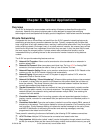
S-ICX-50-200 S-ICX (International) issued October 2000 63
Overview
The S-ICX is designed to accommodate a wide variety of features as described throughout this
document. However, this powerful phone system is also designed to support fast-emerging
technological trends and specialized 3rd-party product integrations. Listed below are some examples.
Private Networking
Companies with two or more offices can benefit from the S-ICX’s powerful networking features by
establishing private phone connections between the sites. Typically, companies with multiple sites
have a high level of call traffic between them, resulting in astronomical phone bills if they’re using the
public switching network (Exchange Lines). In a private network, however, the company pays a fixed
rental fee for the private lines, regardless of how often they are used. In fact, the more they’re used,
the more money the company saves. A private network also provides other benefits, such as
increased efficiency by allowing the user to dial an extension number instead of a long-distance
number.
The S-ICX can provide networking features such as:
❡ Network Call Transfers. Allows a call at an extension to be transferred to an extension in
another network PBX.
❡ Network Call Forward. When two systems are linked via a Tie Line, AC15 or Analog E&M
connection, this feature allows the user to “free up” one of the two Tie Lines.
❡ Network Extension Calling. Allows you to reach an extension on another S-ICX. Based on the
number you dial, the S-ICX network routes the call automatically.
❡ Network Paging. Allows users on one S-ICX system to page on another S-ICX, when the
appropriate Class of Service allows.
❡ Network Call Routing (“Closed Numbering”). Allows multiple systems that are interconnected
in a network, to direct calls to a specific tie line based on the number dialed (the call does not
leave the network). This allows intercom calls to be conducted between locations that would
normally be considered long-distance calling.
❡ Tandem Connection. Allows calls over network tie lines to be automatically routed to another
PBX, out to the public network, or to internal extensions. The tandem relay function increases
network efficiency via automatic routing methods between multiple PBXs, thus reducing the
number of tie lines needed.
❡ Centralized Attendant. Via tie-line routing, operator calls and associated operator functions
(paging, transfer, reversion for unanswered calls) are performed from one Attendant position in
the network.
❡ Centralized Voice Mail. One voice mail system, installed in one of the network PBXs, serves all
extensions in the network. The functions needed for voice mail operation (Call Forwarding to the
user’s mailbox, Priority Message-Waiting to indicate the mailbox message on the user’s phone,
and MSG ID Notification for accessing the mailbox and retrieving messages) are simply
programmed to be routed over the tie lines.
These powerful networking functions are facilitated by the following S-ICX hardware connections:
❡ AC15 Tie Lines. Multiple S-ICX sites can be connected over leased voice lines.
❡ Q-sig Interface. Multiple sites (called “nodes”) can be tied together through network trunk lines,
so that (for example) when one site closes for the day, another node across the country can pick
Chapter 5 - Special Applications


















